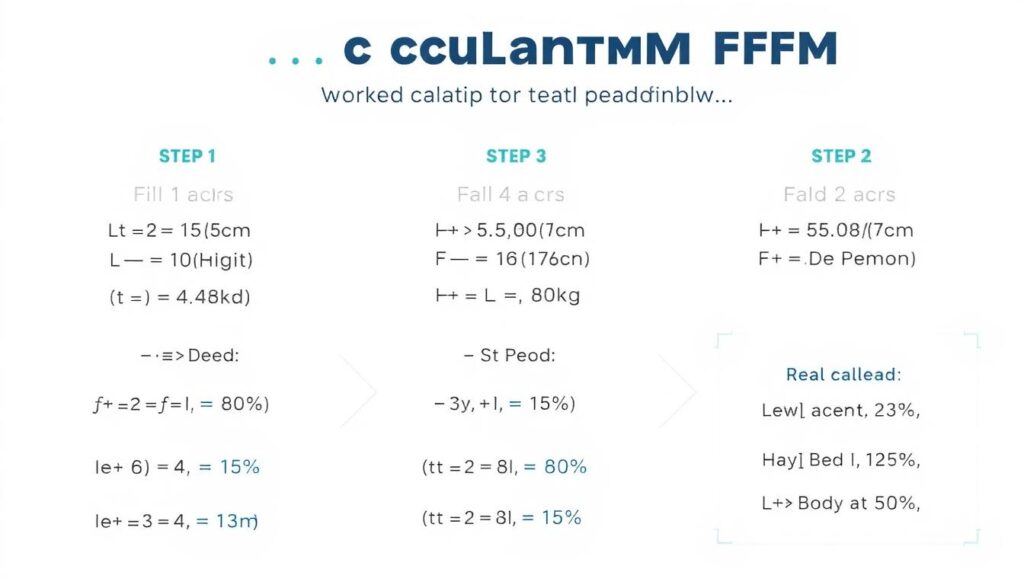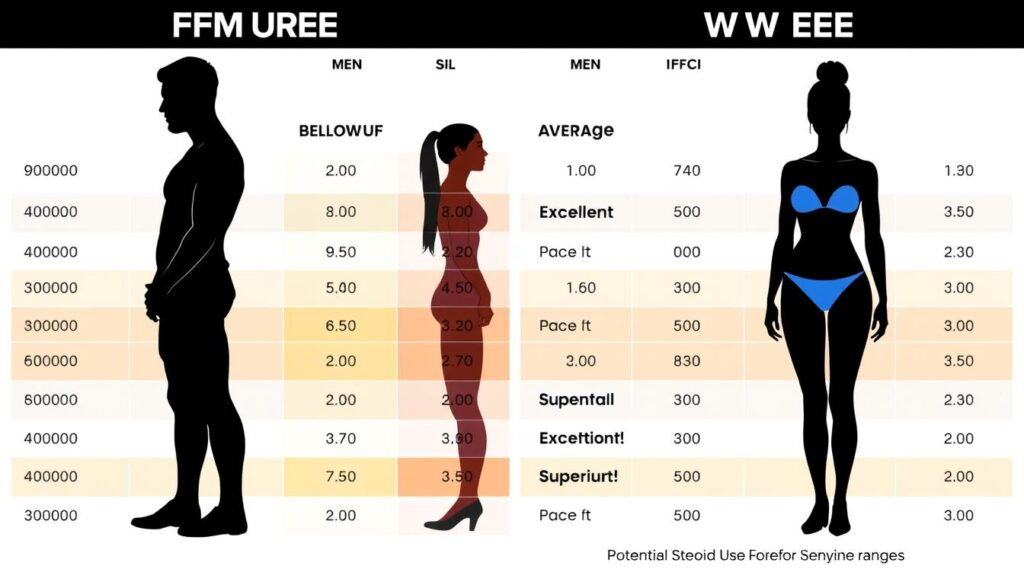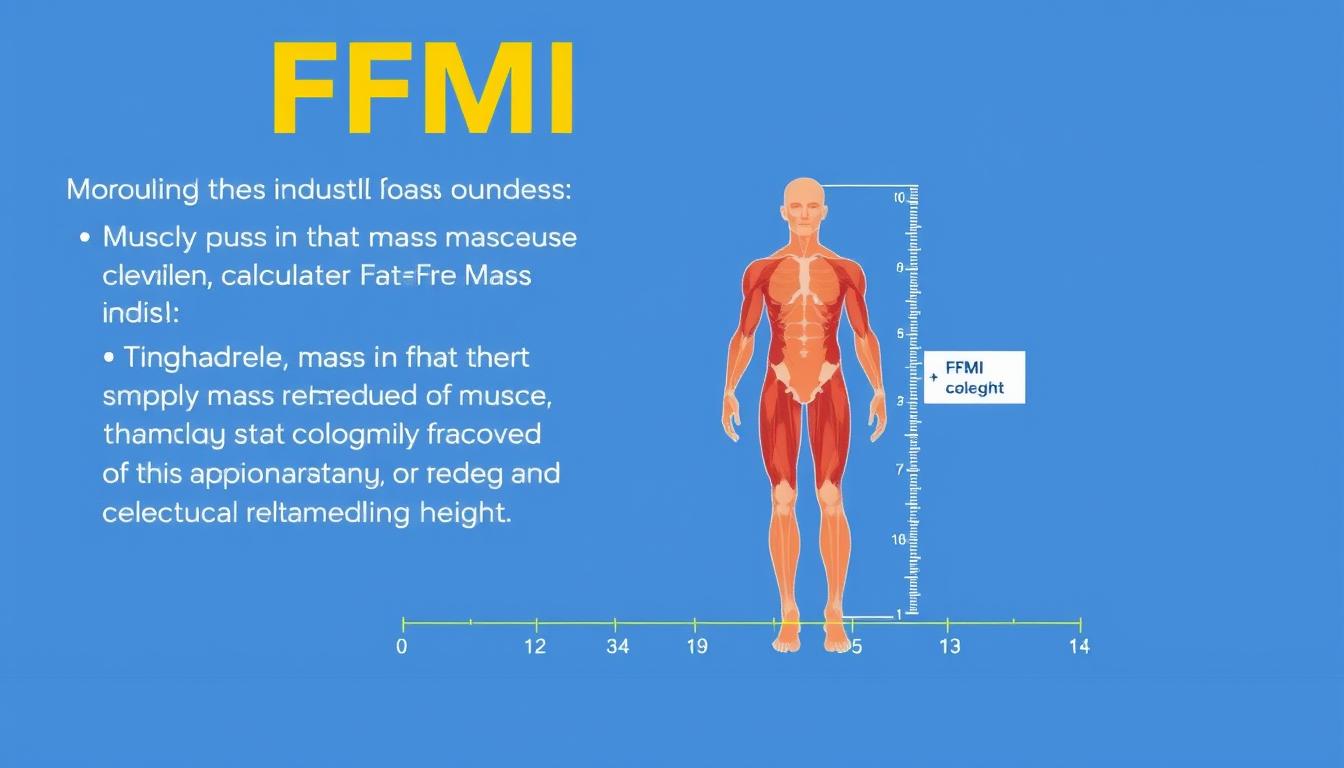What is FFMI (Fat-Free Mass Index)?
FFMI measures muscle mass relative to height, providing a more accurate assessment of body composition
Fat-Free Mass Index (FFMI) is a body composition metric that measures the amount of muscle mass you have in relation to your height. It was developed to overcome the limitations of BMI, which fails to distinguish between fat and muscle weight. FFMI provides a standardized way to assess muscular development regardless of height differences.
The concept is similar to BMI, but instead of using total body weight, FFMI uses only your lean body mass (everything in your body that isn’t fat, including muscles, bones, organs, and water). This makes it particularly valuable for athletes, bodybuilders, and fitness enthusiasts who want to track muscle gains accurately.
Ready to Find Out Your FFMI?
Use our calculator to determine your Fat-Free Mass Index and see how your muscle development compares to established standards.
FFMI vs. BMI: Understanding the Key Differences
While both FFMI and BMI use height and weight measurements, they serve different purposes and have distinct advantages in body composition analysis. Let’s compare these two metrics to understand when each is most useful.
| Feature | FFMI (Fat-Free Mass Index) | BMI (Body Mass Index) |
| Primary Focus | Muscle mass relative to height | Total body weight relative to height |
| Distinguishes Between | Fat mass and lean mass | Does not distinguish between fat and muscle |
| Best For | Athletes, bodybuilders, fitness enthusiasts | General population, initial health screening |
| Requires Body Fat % | Yes | No |
| Accuracy for Muscular Individuals | High | Low (often misclassifies as overweight) |
| Complexity to Calculate | Moderate (requires body fat measurement) | Simple (only height and weight needed) |
The key limitation of BMI is that it treats all body weight equally. This means a muscular athlete might be classified as “overweight” or even “obese” despite having low body fat. FFMI solves this problem by focusing specifically on muscle mass, making it a superior metric for anyone engaged in strength training or muscle-building activities.

Two individuals can have the same BMI but vastly different FFMI scores based on their muscle-to-fat ratio
The FFMI Formula: How to Calculate Your Fat-Free Mass Index
Calculating your FFMI involves a few simple steps. You’ll need to know your height, weight, and body fat percentage to get started.
FFMI Formula
Step 1: Calculate your fat-free mass (FFM):
FFM (kg) = Weight (kg) × (1 – (Body fat % ÷ 100))
Step 2: Calculate your basic FFMI:
FFMI = FFM (kg) ÷ (Height (m))²
Step 3: Calculate normalized FFMI (adjusts for height differences):
Normalized FFMI = FFMI + (6.1 × (1.8 – Height (m)))
The normalized FFMI formula includes an adjustment factor that accounts for the tendency of taller people to have higher FFMI values. This allows for fair comparisons between individuals of different heights.

How to Measure Your Body Fat Percentage
To calculate your FFMI, you need an accurate body fat percentage measurement. Here are the most common methods, ranging from simple to sophisticated:
Skinfold Calipers

Accuracy: Moderate
Cost: Low
Accessibility: High
Calipers measure the thickness of skin folds at specific body sites. While inexpensive and widely available, accuracy depends on the skill of the person taking measurements.
Bioelectrical Impedance Analysis (BIA)

Accuracy: Moderate
Cost: Low to Moderate
Accessibility: High
Found in many modern bathroom scales, BIA sends a small electrical current through your body to estimate fat percentage. Hydration levels can affect accuracy.
DEXA Scan

Accuracy: High
Cost: High
Accessibility: Low
Considered the gold standard for body composition analysis, DEXA scans use low-dose X-rays to precisely measure fat, muscle, and bone mass throughout the body.
For most people, bioelectrical impedance scales provide a good balance of accuracy and convenience. Take measurements under consistent conditions (same time of day, hydration level) for the most reliable results.
Track Your Progress Over Time
Regular FFMI measurements can help you track muscle gains and fat loss more accurately than scale weight alone.
Healthy FFMI Ranges for Men and Women
FFMI scores vary significantly between men and women due to natural physiological differences. Men typically have higher muscle mass and lower essential body fat compared to women. Understanding these differences is important for setting realistic fitness goals.

FFMI Ranges for Men
| FFMI Range | Classification | Typical Body Fat % |
| Below 18 | Below Average | 10-18% |
| 18-20 | Average | 15-20% |
| 20-22 | Above Average | 12-18% |
| 22-23 | Excellent | 10-15% |
| 23-26 | Superior | 8-12% |
| 26-28 | Potential Steroid Use | 6-10% |
| Above 28 | Likely Steroid Use | 5-10% |
FFMI Ranges for Women
| FFMI Range | Classification | Typical Body Fat % |
| Below 15 | Below Average | 20-25% |
| 15-17 | Average | 22-28% |
| 17-18 | Above Average | 20-25% |
| 18-19 | Excellent | 18-23% |
| 19-21.5 | Superior | 15-20% |
| 21.5-25 | Potential Steroid Use | 15-18% |
| Above 25 | Likely Steroid Use | 12-18% |
Research suggests that for natural (non-steroid using) athletes, there appears to be an upper limit to FFMI. For men, this is generally around 25, while for women it’s approximately 22. Values above these thresholds may indicate performance-enhancing substance use, though there are rare genetic exceptions.
Practical Applications of FFMI
Understanding your FFMI can provide valuable insights for various fitness and health goals. Here are some practical ways to use this metric:
Setting Realistic Muscle-Building Goals

FFMI helps establish attainable targets based on your natural potential. Instead of comparing yourself to enhanced athletes, you can set goals within the natural FFMI range for your gender.
Tracking Progress More Accurately

Unlike scale weight, which fluctuates with water retention and doesn’t distinguish between muscle and fat, FFMI specifically tracks changes in muscle mass relative to your height.
Assessing Athletic Potential

Different sports favor different body compositions. FFMI can help identify which activities might be best suited to your natural physique and muscle-building potential.
Real-World Examples of FFMI Application
Case Study 1: Bodybuilding Competition Prep
John, a natural bodybuilder, used FFMI to track his progress during contest preparation. While his weight decreased from 185 to 170 pounds due to fat loss, his FFMI remained stable at 23.5, confirming he was preserving muscle mass despite being in a caloric deficit.
Case Study 2: Strength Sport Transition
Sarah, with an FFMI of 19.8, switched from endurance running to powerlifting. By tracking her FFMI, she could see her muscle gains objectively. After 18 months of training, her FFMI increased to 21.3, reflecting significant muscle development while maintaining similar body fat levels.
Case Study 3: Rehabilitation Progress
After knee surgery, Michael used FFMI to monitor muscle recovery. His affected leg showed a 15% decrease in regional FFMI. Through targeted rehabilitation, he tracked progress until symmetry was restored between both legs, providing objective feedback beyond visual assessment.
Understand Your Body Composition Better
Learn more about how FFMI can help you set realistic goals and track your fitness progress effectively.
Common Misconceptions About FFMI

FFMI Facts
- FFMI is specific to muscle mass relative to height
- Natural genetic limits exist for muscle development
- Women naturally have lower FFMI ranges than men
- FFMI is more useful than BMI for athletic populations
- Regular measurement provides objective feedback on training progress
FFMI Misconceptions
- Higher FFMI always means better health or fitness
- Everyone can achieve the same FFMI with enough training
- FFMI is the only metric needed to assess fitness
- Body fat percentage doesn’t matter if FFMI is high
- FFMI perfectly predicts athletic performance
It’s important to understand that while FFMI is a valuable metric, it should be used as part of a comprehensive approach to fitness assessment. Factors like body fat distribution, muscle symmetry, cardiovascular fitness, and sport-specific skills all contribute to overall athletic performance and health.
“FFMI is a tool, not a goal. The number itself matters less than what you do with your body and how you feel in it. Focus on performance improvements, overall health markers, and sustainable habits rather than chasing a specific FFMI score.”
FFMI Calculator: Determine Your Fat-Free Mass Index
Use this calculator to determine your FFMI. Enter your height, weight, and body fat percentage to get your results.

Conclusion: Making the Most of FFMI
The Fat-Free Mass Index (FFMI) provides a valuable tool for anyone serious about fitness, offering insights that BMI simply cannot. By focusing specifically on muscle mass relative to height, FFMI helps you set realistic goals, track progress accurately, and understand your body’s natural potential.
Remember that while FFMI is useful, it’s just one metric among many. True fitness encompasses strength, endurance, flexibility, skill development, and overall health—not just muscle mass. Use FFMI as a guide, but don’t let it define your fitness journey.
Whether you’re a competitive athlete, a dedicated gym-goer, or someone just starting their fitness journey, understanding your FFMI can provide valuable context for your physical development and help you make more informed training decisions.
Start Your Body Composition Journey
Calculate your FFMI today and gain deeper insights into your muscle development potential.
Frequently Asked Questions About FFMI
What is a good FFMI score?
For men, an FFMI between 20-22 is considered above average, 22-23 is excellent, and 23-26 is superior. For women, 17-18 is above average, 18-19 is excellent, and 19-21.5 is superior. These ranges represent well-developed physiques achievable without performance-enhancing substances.
How often should I measure my FFMI?
For most people, measuring FFMI once every 4-8 weeks provides sufficient data to track progress without obsessing over short-term fluctuations. Body composition changes typically occur gradually, and more frequent measurements may reflect water retention or measurement error rather than true muscle or fat changes.
Can FFMI determine if someone is using steroids?
While FFMI can provide some indication of potential steroid use, it’s not definitive proof. Research suggests that men with an FFMI above 25 and women above 22 (when lean) may have used performance-enhancing substances, but there are exceptions due to genetics, measurement errors, and other factors. FFMI should be considered alongside other indicators rather than used as the sole determinant.
How does FFMI change with age?
FFMI typically peaks in the late 20s to early 30s and gradually declines with age due to natural muscle loss (sarcopenia). However, resistance training can significantly slow this decline. Older individuals should compare their FFMI to age-appropriate references rather than to younger populations.
Can I improve my FFMI without gaining weight?
Yes, through body recomposition—simultaneously building muscle while losing fat. While this process is slower than dedicated bulking and cutting phases, it allows for FFMI improvement without significant weight changes. This approach works best for beginners, those returning after a break, and individuals with higher body fat percentages.

